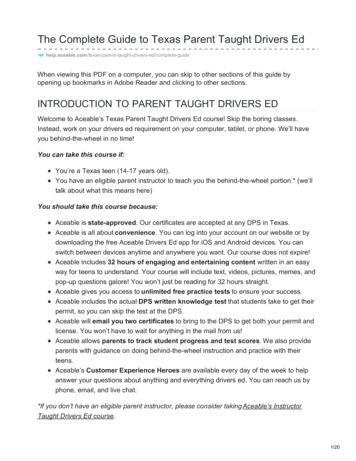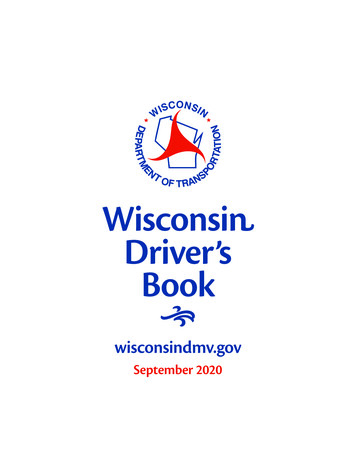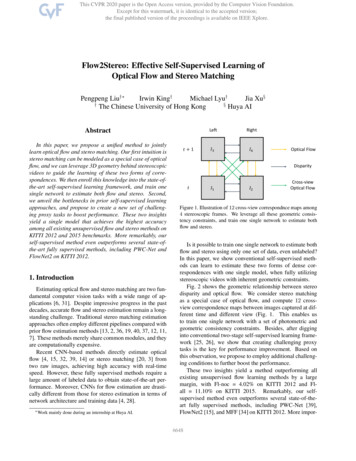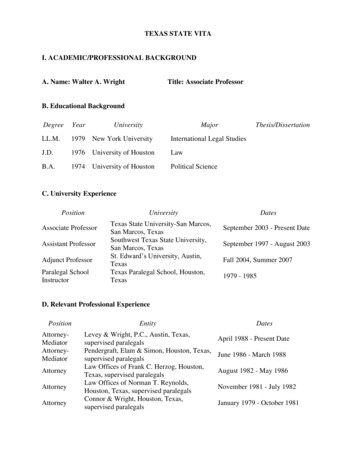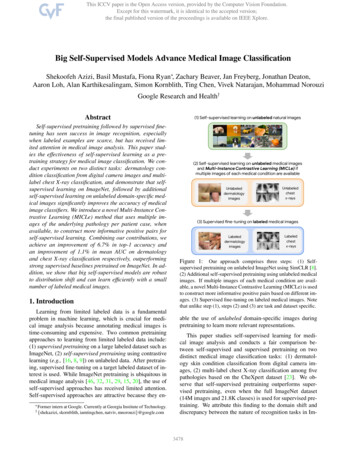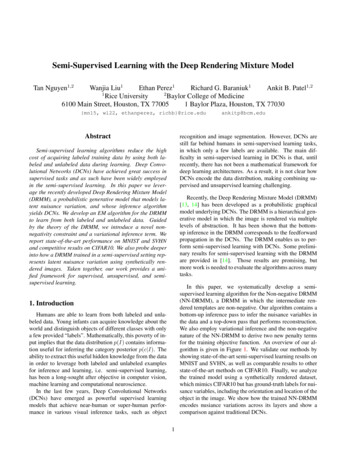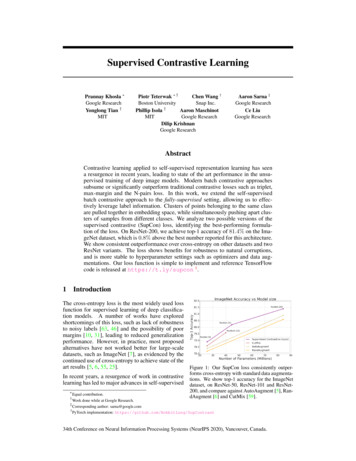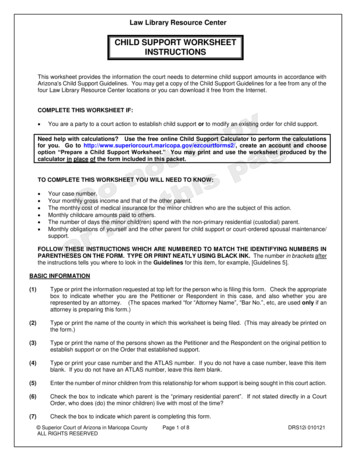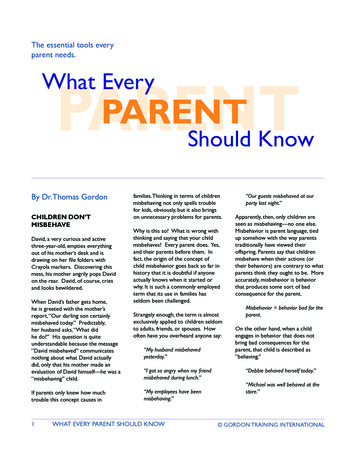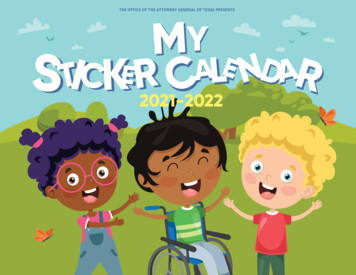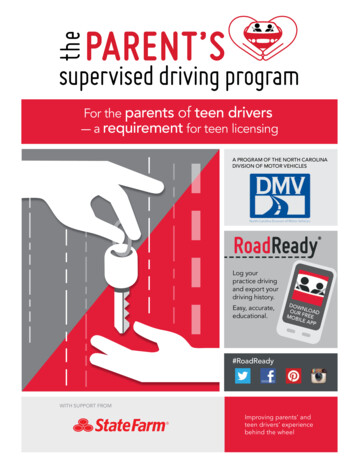
Transcription
thePARENT’Ssupervised driving programFor the parents of teen drivers— a requirement for teen licensingA PROGRAM OF THE NORTH CAROLINADIVISION OF MOTOR VEHICLESLog yourpractice drivingand export yourdriving history.Easy, accurate,educational.DOWNOUR LOADMOB FREEILE APP#RoadReadyWITH SUPPORT FROMImproving parents’ andteen drivers’ experiencebehind the wheel
From carcar seatFromtodriver’sdriver’s seat.seat.toIt’s hard to believe they’re already in the driver’s seat, but one thing hasn’tIt’schangedhard to–believethey’rethe themdriver’sseat,thingabouthasn’thow muchyoualreadywant toinkeepsafe.Talkbutto onean agentchangedhow muchwant toandkeepthem safe.Talk to orangetagentaboutatour teen–driversafetyyouprogramsinsurancediscounts,a quoteTM ourteen driver safetyprogramsdiscounts,a quoteatstatefarm.com. It’s justanotherandwayinsurancewe’re hereto help lifeorgogetright.TM statefarm.com . It’s just another way we’re here to help life go right.State Farm Mutual Automobile Insurance omobileInsurance CompanyBloomington,IL CompanyStateFarm IndemnityBloomington, ILState Farm County Mutual Insurance Company of TexasRichardson, TXState Farm County Mutual Insurance Company of TexasRichardson,1701321 TX1701321
NORTH CAROLINA DIVISION OF MOTOR VEHICLESA Message to Parents and Guardiansfrom N.C. DMVWelcome to the Parent’s Supervised Driving Program.Thank you for helping your teen become a resourceful, responsible and respectful driver.These traits have never been more important than they are today. With your help, your teen driver will learnhow their actions affect others on the road and recognize ways to prevent accidents.Your time supervising your young driver is critical. You help them learn to put away their cell phone while theydrive. You help set boundaries for avoiding distractions -- boisterous friends in the car, the radio, texts, andphone calls.This booklet helps parents take an active role in their child’s driving education.It is designed to assist supervising drivers in documenting young drivers’ time and practice on driving logs thatare required by North Carolina’s graduated licensing program.Thank you for your efforts to teach your child safe, responsible driving behavior. You are helping to keep ourhighways safe for everyone and preparing your child for a lifetime of success on the road.Roy CooperGovernorJ. Eric BoyetteSecretary of Transportation
@PSDP Info thank you!I love this app so much.- Twitter FollowerA component ofthePARENT’Ssupervised driving programDownload our FREE mobile appto log your Learner’s Permit practice driving.SMARTLog your drives, includingdriving conditions (roadtype and weather),driving notes, staterequirements & more.SOCIALSYNCShare drives andaccomplishments withfriends on social networkswith RoadReady’s socialsharing options.Connect one teen driver’spractice drive time acrossmutiple phones by usingthe same log-in on eachdevice.WITH SUPPORT FROMLEARN MORE AT ROADREADYAPP.COMApple, the Apple logo and iPhone are trademarks of Apple Inc., registered in the U.S. and other countries. App Store is a service mark of Apple Inc.
Sponsor messageA driver’s license is a huge milestone in your teen’s life, and one to be celebrated. As a parent, it canalso leave you feeling concerned about your child’s safety. State Farm chose to be a part of TheParent’s Supervised Driving Program to help parents guide a new generation of drivers to become safer,confident and more experienced every time they’re behind the wheel.State Farm understands that motor vehicle injuries are one of our country’s most important public healthproblems. In fact, car crashes are the #1 killer of teens, and the first few months of unsupervised drivingare the most dangerous.1 As the nation’s leading auto insurer,2 State Farm has been an integral part oflandmark teen driver research to help us and others understand how so many of these car crashes canbe avoided. We’ve also learned new drivers need and want parental involvement. By providing teenswith significant practice on a variety of driving skills and conditions, parents can make a huge impact inkeeping the roads safer for everyone.Through continued research and funding, State Farm is committed to preventing injuries and savinglives. We also work with national and local organizations to bring ongoing attention to auto safety issuesand legislation. Across the U.S., more than 18,000 State Farm agents are making a difference too, byincreasing awareness around safe driving and the impact new drivers have on the roads.We encourage you to read this program guide and know that you will make a difference in your teen’ssafety, wherever the road takes them. Together, we can make this milestone a real celebration for yourchild and you.1 – https://www.cdc.gov/motorvehiclesafety/teen drivers/teendrivers factsheet.html2 – w/company-profile/fast-facts
Developed by Safe Roads Alliance, a nonprofit dedicated to promoting safer drivingthrough education for drivers of all ages,The Parent’s Supervised Driving Programis designed to improve teen driver safetyby providing parents and guardians with amethodical approach to teaching the requisitedriving skills. Each lesson concentrates on aparticular sequential skill. Parents are in thebest position to help their teens become safe,smart, and skilled drivers.The Parent’s Supervised Driving Programalso includes a website, social media pages,and a mobile app, RoadReady .Publisher: Safe Roads Alliance info@saferoadsalliance.orgIllustrator: Lou EisenmanThanks to the following for help in developingthis program: Jeff Larason, TravelersMarketing, In Control Family Foundation,Colleen Kelly Carr and Lisa Kennedy-Cox.Special thanks to Terry Fuller, CharlotteBoyd-Malette, Jennifer Keel, Paula Windleyand at the North Carolina DMV.Published in association with the NorthCarolina Division of Motor Vehicles withsupport from State Farm .State Farm and the State Farm logo areregistered trademarks of State Farm MutualAutomobile Insurance Company.Copyright 2017 J.F. Griffin Publishing andSafe Roads Alliance. All rights reserved.Printed in the United States of America.Produced by J.F. Griffin Publishing.PARENT’StheAbout this programsupervised driving programWelcome parentsof teen drivers!The Parent’s Supervised Driving Program is a resource forparents to utilize when teaching their teen to drive.1. T his program is divided into core driving skills. R ead through each section at home beforeyour teen starts a new skill.2. Log your driving time. This can be done 2 ways: C arry this printed guide with you during thedrive and use the printed log section – you oryour teen can log the supervised driving hoursonce the drive is finished.app Download and use the freeto track your driving time. RoadReady tracksyour teen’s driving hours until you reach thestate requirements. Download for free on theApp StoreSM.3. Turn in your log when applying for your license.This program is alsoavailable online at:PSDPonline.comStay Connectedwith ivingProgramFollow The Parent’s SupervisedDriving Program for expertdriving articles, program launchevents and additional dyappTwitterwww.twitter.com/PSDP Info
NORTH CAROLINA DIVISION OF MOTOR VEHICLESTable of contentsNotes for parents/guardiansAbout supervising teen drivers . . . . . . . . . . . . . . . . . . . . . . . . . . . . . . . . . . . . . . . . . . . . . . . . . . . . . . . . . . . . . . . . . . . . . . . . . . . . . . . . . . . . . 1Vehicle control for supervisors. . . . . . . . . . . . . . . . . . . . . . . . . . . . . . . . . . . . . . . . . . . . . . . . . . . . . . . . . . . . . . . . . . . . . . . . . . . . . . . . . . . . . . 2Distracted driving and more . . . . . . . . . . . . . . . . . . . . . . . . . . . . . . . . . . . . . . . . . . . . . . . . . . . . . . . . . . . . . . . . . . . . . . . . . . . . . . . . . . . . . . . . 3SkillsSkill one: before you start the engine. . . . . . . . . . . . . . . . . . . . . . . . . . . . . . . . . . . . . . . . . . . . . . . . . . . . . . . . . . . . . . . . . . . . . . . . . . . . . . 4Skill two: moving, steering and stopping. . . . . . . . . . . . . . . . . . . . . . . . . . . . . . . . . . . . . . . . . . . . . . . . . . . . . . . . . . . . . . . . . . . . . . . . . . 5Skill three: how close are you? . . . . . . . . . . . . . . . . . . . . . . . . . . . . . . . . . . . . . . . . . . . . . . . . . . . . . . . . . . . . . . . . . . . . . . . . . . . . . . . . . . . . . . 6Skill four: backing up. . . . . . . . . . . . . . . . . . . . . . . . . . . . . . . . . . . . . . . . . . . . . . . . . . . . . . . . . . . . . . . . . . . . . . . . . . . . . . . . . . . . . . . . . . . . . . . . . 7Skill five: driving on a quiet street – part one . . . . . . . . . . . . . . . . . . . . . . . . . . . . . . . . . . . . . . . . . . . . . . . . . . . . . . . . . . . . . . . . . . . . . 8Skill five: driving on a quiet street – part two. . . . . . . . . . . . . . . . . . . . . . . . . . . . . . . . . . . . . . . . . . . . . . . . . . . . . . . . . . . . . . . . . . . . . . 9Skill six: looking ahead. . . . . . . . . . . . . . . . . . . . . . . . . . . . . . . . . . . . . . . . . . . . . . . . . . . . . . . . . . . . . . . . . . . . . . . . . . . . . . . . . . . . . . . . . . . . . . 10Skill seven: turning around . . . . . . . . . . . . . . . . . . . . . . . . . . . . . . . . . . . . . . . . . . . . . . . . . . . . . . . . . . . . . . . . . . . . . . . . . . . . . . . . . . . . . . . . . 11Skill eight: parking – part one. . . . . . . . . . . . . . . . . . . . . . . . . . . . . . . . . . . . . . . . . . . . . . . . . . . . . . . . . . . . . . . . . . . . . . . . . . . . . . . . . . . . . . 12Skill eight: parking – part two. . . . . . . . . . . . . . . . . . . . . . . . . . . . . . . . . . . . . . . . . . . . . . . . . . . . . . . . . . . . . . . . . . . . . . . . . . . . . . . . . . . . . . 13Licensing for drivers 15-18. . . . . . . . . . . . . . . . . . . . . . . . . . . . . . . . . . . . . . . . . . . . . . . . . . . . . . . . . . . . . . . . . . . . . . . . . . . . . . . . . . . . . . . . . . 15Supervised driving log. . . . . . . . . . . . . . . . . . . . . . . . . . . . . . . . . . . . . . . . . . . . . . . . . . . . . . . . . . . . . . . . . . . . . . . . . . . . . . . . . . . . . . . . . . . . . . 16Skill nine: multi-lane roads – part one. . . . . . . . . . . . . . . . . . . . . . . . . . . . . . . . . . . . . . . . . . . . . . . . . . . . . . . . . . . . . . . . . . . . . . . . . . . . . 21Skill nine: multi-lane roads – part two. . . . . . . . . . . . . . . . . . . . . . . . . . . . . . . . . . . . . . . . . . . . . . . . . . . . . . . . . . . . . . . . . . . . . . . . . . . . . 22Skill ten: city driving – part one . . . . . . . . . . . . . . . . . . . . . . . . . . . . . . . . . . . . . . . . . . . . . . . . . . . . . . . . . . . . . . . . . . . . . . . . . . . . . . . . . . . . 23Skill ten: city driving – part two . . . . . . . . . . . . . . . . . . . . . . . . . . . . . . . . . . . . . . . . . . . . . . . . . . . . . . . . . . . . . . . . . . . . . . . . . . . . . . . . . . . . 24Skill eleven: highway driving – part one. . . . . . . . . . . . . . . . . . . . . . . . . . . . . . . . . . . . . . . . . . . . . . . . . . . . . . . . . . . . . . . . . . . . . . . . . . . 25Skill eleven: highway driving – part two. . . . . . . . . . . . . . . . . . . . . . . . . . . . . . . . . . . . . . . . . . . . . . . . . . . . . . . . . . . . . . . . . . . . . . . . . . . 26Beyond the basicsContinuing education. . . . . . . . . . . . . . . . . . . . . . . . . . . . . . . . . . . . . . . . . . . . . . . . . . . . . . . . . . . . . . . . . . . . . . . . . . . . . . . . . . . . . . . . . . . . . . . 27Practice in other conditions . . . . . . . . . . . . . . . . . . . . . . . . . . . . . . . . . . . . . . . . . . . . . . . . . . . . . . . . . . . . . . . . . . . . . . . . . . . . . . . . . . . . . . . . 28Teens’ biggest dangers. . . . . . . . . . . . . . . . . . . . . . . . . . . . . . . . . . . . . . . . . . . . . . . . . . . . . . . . . . . . . . . . . . . . . . . . . . . . . . . . . . . . . . . . . . . . . 29Sharing the road. . . . . . . . . . . . . . . . . . . . . . . . . . . . . . . . . . . . . . . . . . . . . . . . . . . . . . . . . . . . . . . . . . . . . . . . . . . . . . . . . . . . . . . . . . . . . . . . . . . . . 30Sharing the road with bicyclists and pedestrians. . . . . . . . . . . . . . . . . . . . . . . . . . . . . . . . . . . . . . . . . . . . . 31WITH SUPPORT FROMYour opinionmattersTake our programsurvey and tell us aboutyour com/survey
NOTES FOR PARENTS/GUARDIANSAbout supervising teen driversThe Parent’s Supervised Driving Program gives you a simple, easy-to-follow plan you can use to helpyour teen be a safe and responsible driver.Some thoughts as you begin this exciting experience together:Make an effort to enjoy the learning process: Driving is a big step toward independence, and yourteen is entering a new phase of life. You’ll both remember this experience for years to come. Make it agood memory!Stay FocusedAt the start of eachdriving lesson with yourteen, leave your problemsbehind — and make aneffort to stay focused.Don’t bring up touchysubjects such as grades,homework, boyfriends/girlfriends, and anythingelse that might distracteither of you from thetask at hand.Practice makes perfect: Studies show that the risk of a crash diminishes with experience. The moretime you can spend driving with your teen, the less likely it is they’ll crash when they begin drivingalone. Driving in a variety of circumstances is equally important. While using this program, you shoulddrive on all types of roads. Make sure your teen gets exposure to a variety of roadways, and in differentconditions as well: at night; in rain, fog, and snow; and in heavy and light traffic.Be a driving role model: It’s not enough to say, “Do as I say.” Children imitate their parents’/guardians’behavior, so your driving should set a good example for your teen to emulate. Be sure that you: Obey all traffic laws. Correct any unsafe driving habits (driving aggressively, rolling through stop signs, accelerating throughyellow lights, speeding, etc.). Refrain from using your cell phone or texting while driving.Tips for teaching your teen Seat belts must always be worn properly by everyone in the vehicle. Before each session, discuss the goals of the day’s lesson. Before each new lesson, review what was learned during the previous lesson. Keep instructions simple and concise. Say where to go and what action to take. For example: “Driveto the corner and turn right.”The feedback you give should be calm, precise, and immediate. Be patient and alert at all times.Remember to give positive feedback when your teen succeeds!When your teen makes a mistake, which will happen often, do not criticize. Remain calm and simplyrepeat the maneuver until it’s done correctly. To minimize their frustration, emphasize to your teen thatmistakes are a normal part of learning.These lessons should be consistent with what is taught by your teen’s driving instructor. If you teachsomething differently, your teen will be confused and learning will be more difficult. If the lessons inthis program are different from the instructor’s, contact them to clarify the discrepancy.Remember that students learn at different paces. Make sure your teen has mastered each skillbefore you move on to the next lesson, even if that means repeating a lesson several times. Patienceand practice will pay off in the long run.Integrate night driving into as many lessons as possible.Most importantly, make sure the vehicle you use for training is safe. Confirm that the brakes havebeen recently inspected, and check to make sure the tires have sufficient tread depth. It’s generallyrecommended that you do not train in larger vehicles that lack stability control.1
NOTES FOR PARENTS/GUARDIANSVehicle control for supervisorsTeaching a new driver can be stressful, but knowing you have some control can help. Professionaldriver’s education instructors are taught emergency responses to potential hazards that can crop upwith an inexperienced driver behind the wheel. Here are some skills you can learn to help you maintaincontrol from the passenger seat while teaching:Emergency shifting: In a quiet, large, level, empty area, practice shifting the transmissionfrom drive to neutral.Taking the wheel: With an experienced driver in the driver’s seat, in a quiet, large, level,empty area, practice steering the car with your left hand from the passenger seat.Mirrors: Adjust the mirror on the passenger sun visor so you can use it as a rearviewmirror. If the right side mirror is properly adjusted, you can use it to monitor traffic to therear from the passenger seat.Awareness: Never assume everything is okay. Always check and re-check mirrors beforeyou give instructions to your teen.Emergency stopping: Practice stopping the car with the parking brake (if your vehicle’sparking brake is located between the seats). This can be dangerous, even at low speeds,and should only be used as a last resort.Driving has changedChances are, today’s cars are not the same as they were when you learned to drive. To teach your teeneffectively, you need to know about a few important recent changes in how cars work, how we drive,and how driving is taught.Anti-lock Brake System (ABS): Most newer cars offer ABS as either standard or optional equipment.ABS is a dramatic safety improvement that works by letting the tires rotate, rather than lock up, when thebrake is engaged. This allows drivers to turn the car in an emergency stop. ABS should be used with firm,continuous pressure. The brakes may shake and grind when applied, which often concerns users – butthis is a normal function of ABS. To find out if your car has ABS, check the instrument panel after you turnon the ignition or read the owner’s manual.CommentarydrivingCommentary driving isa great communicationtool. Coach yourteen to describe theiractions, thoughts andobservations out loudas they drive, similar toa sports commentator.Throughout the learningprocess, ask them toverbalize what they seearound them, includingpotential risks and anysteps they need to take toavoid those risks.Note: When driving a car without ABS, the old rules still apply. Don’t “slam” the brakes. Rather, press thebrake pedal firmly. The intention is to stop quickly, but also to avoid locking the brakes and skidding.Skidding causes a loss of control and requires more distance to stop.Air bags: Air bags are designed to work with seat belts, which must beworn for the air bags to be effective. Since air bags deploy out of thewheel on impact, it’s important to keep your hands and arms clear.Steering wheel hand position: Most of us were taught to position ourhands at 10 and 2 o’clock on the steering wheel. It’s now suggestedthat you hold the wheel at 9 and 3 o’clock. This gives you better vehiclecontrol.Arms holding the wheelat 9 and 3 o’clock arenot as likely to be hit bythe air bag.2
NOTES FOR PARENTS/GUARDIANSDistracted driving and moreDistracted driving involves any activity, such as cell phone use, that has the potential to distractsomeone from the task of driving. Distracted driving, alcohol, speeding, and not wearing seat beltscan lead to death and injury in crashes. Teens, who are still learning the complex skills of driving, areparticularly susceptible to distractions while behind the wheel. Don’t let you or your teen becomeanother statistic. Here are the facts:Eyes on the roadTeens tend to look awayfrom the road and becomedistracted for longerperiods than older drivers.It’s important to train themto keep their eyes on theroad ahead. Test your teenon how long they lookaway when doing varioustasks inside the vehicle,such as tuning the radio.Coach them repeatedlyon the importance offocusing on the roadahead. Motor vehicle crashes are the leading cause of death for U.S. teens. Mile for mile, teens are involvedin 3 times as many fatal crashes as all other drivers. And 1 in 3 teens who text say they have done sowhile driving. In 2014, 3,179 people were killed and an estimated 431,000 people were injured in crashes involvinga distracted driver. That’s an 11 percent increase from the estimated 387,000 injured in 2011. A Virginia Tech Transportation Institute study revealed that physically dialing a phone while drivingincreases the risk of a crash as much as 6 times. Texting is riskier still, increasing collision risk by23 times.To combat this growing epidemic, we suggest the following: 3Set a good example: Kids observe and learn from their parents. Put your phone down while drivingand only use it when you are safely pulled over. According to the Pew Research Center, 40 percentof teens 12 to 17 say they have been in a car when the driver used a cell phone in a way that putthemselves and others in danger.Talk to your teen: Discuss the risks and responsibilities of driving and the danger of dividing theirattention between a phone call and the road. Show them the statistics related to distracted drivingand urge them to share what they learn with their friends.Establish ground rules: Set up family rules about not texting while behind the wheel. Enforce thelimits set by the Graduated Licensing Program.Sign a pledge: Have your teen take action by agreeing to a family contract about wearing safetybelts, not speeding, not driving after drinking, and not using a cell phone behind the wheel. Agree onpenalties for violating the pledge, including paying for tickets or loss of driving privileges.Other dangerous distractions: In addition to cell phone use, distracted driving can include eating,grooming, drinking, listening to or adjusting the radio or MP3 player, using the GPS, talking topassengers, or watching a video, just to name a few activities. Inexperienced drivers are particularlysusceptible to these kinds of distractions.
SKILL ONE: BEFORE YOU START THE ENGINEBefore you start the engineGoal: Teach your teen vehicle basics before actual driving begins.Location: Parked. This is a non-driving lesson.Lesson one – touring the vehicleWalk around the outside of the car with your teen. Instruct them to look for leaks and hazards such asbroken glass, and to make sure it’s clear behind the vehicle as well as in front of the vehicle.Have your teen practice these basic skills until they don’t need help: Starting and stopping the engine Naming and operating all dashboard controls Checking oil level Checking wiper fluid Checking tire pressureProper mirrorsettingLesson two – mirror settingsThe method below provides the best view of adjacent lanes, for maximum safety. Inside mirror: Have your teen sit up straight in the driver’s seat and adjust the inside mirrorso that it frames the entire rear window. This is the main mirror for viewing what is behind the vehicle. Left-side mirror: Have your teen lean their head toward the left-side window, and set the left mirror sothey can barely see the side of the car. When they sit up straight, the car should no longer be visible inthe mirror.In the past, drivers wereoften taught mirrorsettings that causedoverlap between therear and side mirrors,which was less safe. Thisis a great opportunity toupdate your own drivingskills while teachingyour teen!Right-side mirror: Do the same to the right. Have your teen lean to the right over the car’s centerconsole, and set the right mirror so they can barely see the right side of the car.Understanding hand signalsIt is important for your teen to understand hand signals in case the vehicle signals are not working andto ensure the safe sharing of the road with cyclists.Lesson three – checking blind spotsAdditionally, teach your teen how to look over their shoulder to check the“blind spot” on each side of the car that cannot be seen in the mirrors.Lesson four – seating positionThe proper seat position is important to safely control the vehicle. Your teenshould sit with their back firmly against the seat. There should be at least 10inches between the steering wheel and the driver’s chest, with the air bagpointing at the chest. The top of the steering wheel should be no higher thanthe shoulders. Move the seat forward or backward so that the driver’s heeltouches the floor and can pivot between the brake and accelerator. Shorterdrivers may need a seat cushion or pedal extenders to sit safely 10 inches fromthe air bag. The head restraint should be at the center of the driver’s head.The most effective way todeal with blind spots is tobriefly turn and look.Skill completedsupervisor initialsdriver initials#RoadReady4
SKILL TWO: MOVING, STEERING, AND STOPPINGMoving, steering, and stoppingGoal: Teach your teen to consistently start, stop, and turn smoothly with full vehicle control.Location: A large, level, mostly empty area.Everyone in the vehicle must be properly buckled up.Before starting, coach your teen to always signal and check mirrors and blind spots before changing thespeed, position, or direction of the car. Remind them when needed.Reducing speedNew drivers tend to usethe brake too much andthe accelerator too littleto control speed. Coachyour teen about easingup on the gas pedal as away to reduce the car’sspeed.Have your teen drive around the perimeter of the lot several times at a slow speed. Have them stop andstart frequently, practicing smooth hand-to-hand steering, braking, and accelerating.Pick several targets in the large, level, empty practice area, and have your teen drive to them at specificspeeds. For example, “Drive to the stop sign at 15 mph.” Focus on steady speed and smooth starts andstops.Once your teen is braking smoothly, practice “hard, smooth stops” at slightly higher speeds(approximately 25–30 mph). Hint: Curling toes back just before braking results in smoother stops. Iteases the pressure on the brake.Lesson one – steps toward turningTurning leftTurning rightStep 1Left handslides downRight handpulls downLeft handpulls downRight handslides downRight handslides upLeft handslides upRight handpushes upRight handpulls downLeft handpulls downRight handslides downStep 2Left handpushes upStep 3Left handslides downWith hand-to-hand steering your hands do not cross each other.Lesson two – turning techniquesSkill completedsupervisor initialsdriver initials#RoadReady5 Ease off the accelerator or use the brake to reduce speed before entering a curve; use gentleacceleration to overcome inertia and pull the vehicle out of the curve. Use smooth, continuous steering wheel movements when approaching a turn and when returning(sliding) the wheel through the hands until the vehicle is in the proper post-turn position. Coach your teen to pick a target near the center of the intended travel path. This target can beused as a visual aid to aim at while steering through turns.
SKILL THREE: HOW CLOSE ARE YOU?How close are you?Goal: Teach your teen how to tell where their vehicle is in relation to other vehicles or objects.Location: A large, level, mostly empty area with clearly painted pavement lines and curbs.Reference pointsExplain to your teen that reference points are visual guides to help them judge the car’s distance fromcurbs, lines, other objects, and vehicles.Lesson one – driver’s side curb (or line) View out the front windshield.Reference points will be differentfor everyone, depending on thevehicle and the height of the driver. hoose a pavement curb (or line), and tell your teen that the goalCis to pull the driver’s side of the vehicle 6–12 inches away. Coachthem to slowly pull up parallel to the line, getting gradually closer,and stop when they think they are 6–12 inches away. Have themlook at where the line intersects in the front window. Haveyour teen put the car in park and get out to check if thedriver’s side wheels are 6–12 inches from the line. If it’s not theright distance, have them do it again, checking the referencepoints.Lesson two – passenger’s side curb (or line) hoose another curb (or line) parallel to the passenger’s side,Cagain pulling up slowly to within 6–12 inches. Use the samegradual pull-up method, but for this side, coach your teen to stopwhen the curb appears to intersect the center of the hood. gain, have your teen get out of the vehicle to check whether theAtires are 6–12 inches from the curb. Keep practicing and makingadjustments, noticing the reference point, until they can do itconsistently.Making yourteen saferIt takes more than15 minutes every day forsix months to complete50 hours of practicedriving. For 100 hours,it’s more than 30 minutesa day for six months.Studies show that themore time you drivetogether, the safer yourteen will be when drivingalone.View out the front windshield.Reference points will be differentfor everyone, depending on thevehicle and the height of the driver.Lesson three – front curb (or line)View out the driver’s side window.Reference points will be differentfor everyone, depending on thevehicle and the height of the driver. each your teen to align the front bumper between 6–12 inchesTfrom a pavement curb (or line). Have them drive slowly straighttoward the curb. Coach them to stop when the curb appearsunder the passenger’s side mirror. ave your teen get out of the vehicle to check whether theHfront bumper is 6–12 inches from the curb. If not, have themadjust the reference point as needed and keep practicing.Skill completedsupervisor initialsdriver initials#RoadReady6
SKILL FOUR: BACKING UPBacking upGoal: Teach your teen how to safely drive backwards in a straight line and while turning.Location: A large, level, mostly empty area.Lesson one – before moving the vehicle Coachyour teen that they must t
2. Log your driving time. This can be done 2 ways: Carry this printed guide with you during the drive and use the printed log section – you or your teen can log the supervised driving hours once the drive is finished. Download and use the free app to track your driving time. RoadR
